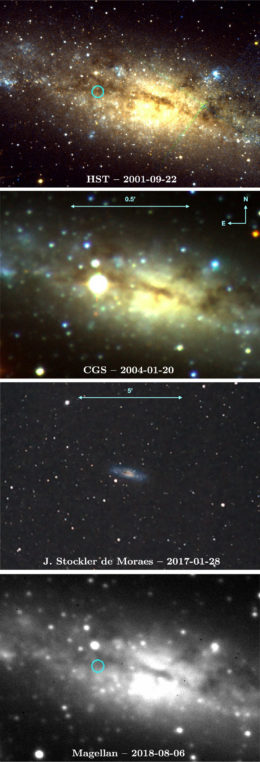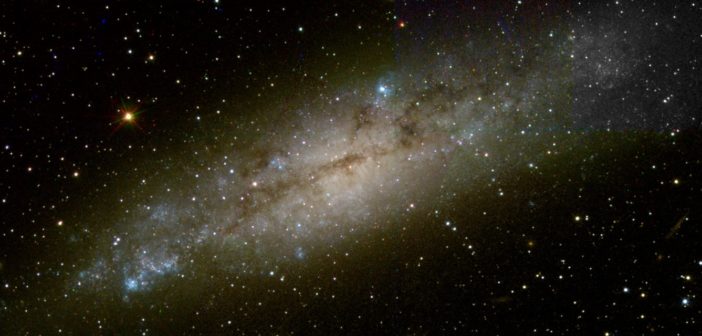Much of today’s astronomy happens via methodical searches, but sometimes serendipitous discoveries still surprise us. Such is the case with the transient CGS2004A, a possible supernova recently detected in a galaxy nearly 50 million light-years away.
Observing Explosions
Supernovae — some of the brightest phenomena in our universe — are vast explosions thought to mark the destruction of stars in the end stages of their evolution.
The history of supernova observations is long: the first recorded supernova was seen in China in 185 AD! Because supernovae are scarce (there are perhaps 1–3 per century in the Milky Way) and their brightest stages of are short-lived (lasting just a few months), only a handful of supernova were spotted by naked eye through the ages. The invention of the telescope, however, changed this: as technology improved, astronomers became able to observe bright supernovae in galaxies beyond the Milky Way.

Chronological observations of NGC 1892. From the top, a Hubble image from 2001, the CGS image from 2004, Stockler de Moraes’s image from 2017, and a Magellan image from 2018. The transient is visible only in the 2004 CGS image. [Guillochon et al. 2018]
An Unexpected Find
In January of 2017, Stockler de Moraes imaged the distant galaxy NGC 1892 using a 12-inch diameter telescope. When he later compared his image to an archival image from 2004 of the same galaxy, taken as part of the Carnegie-Irvine Galaxy Survey (CGS), he discovered a distinct difference between the two photos: a bright source was present in the archival image that wasn’t visible in his recent photo.
Stockler de Moraes next contacted astronomer James Guillochon (Harvard Center for Astrophysics), who first eliminated possible alternate explanations for the source — such as minor planets in our solar system that might have coincided with NGC 1892 at the time. Guillochon then worked with a team of collaborators to explore other images of the galaxy and conduct follow-up imaging, as well as analyze the transient in the CGS image.
Core Collapse
The transient — labeled CGS2004A — was found to be absent in all additional images the authors explored, both in years before and after the CGS observation. Guillochon and collaborators’ photometric analysis of the transient and our knowledge of the nature of NGC 1892, a massive, star-forming galaxy, further suggest that this transient was likely a Type IIP supernova, caused when the core of a massive star (perhaps 8–50 solar masses) suddenly collapses.
Based on the authors’ analysis, it would seem that Stockler de Moraes serendipitously discovered a stellar explosion that went unnoticed 14 years ago. Discoveries such as these help us to continue to expand our understanding of how stars evolve throughout the universe.
Bonus
For a cool way to experience the history of supernova detections over time, check out the video by astronomer Greg Salvesen below. Chronological discoveries of supernovae are displayed both visually and using sound, for the time period of 1950 to the start of 2018. You can skip ahead to ~1990 to see detection rates pick up as more surveys come online! Data is from the Open Supernova Catalog by Guillochon et al.
Citation
“Serendipitous Discovery of a 14-year-old Supernova at 16 Mpc,” James Guillochon et al 2018 Res. Notes AAS 2 165. doi:10.3847/2515-5172/aade89

6 Comments
Pingback: Aficionado descubre supernova de hace 14 años ⋆ Peru Online
Pingback: Surprise Discovery of a 14-Year-Old Supernova – AstroBrief
Pingback: Two Explosions with Similar Quirks – CityGov
Pingback: Two Explosions with Similar Quirks - Levpros
Pingback: Two Explosions with Similar Quirks – AstroBrief
Pingback: Amateur discovers supernova 14 years ago - Be Viral